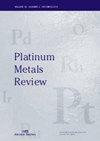Faraday Discussion 155: Artificial Photosynthesis
引用次数: 0
Abstract
Molecular Photonics Laboratory, School of Chemistry, Newcastle University, Bedson Building, Newcastle upon Tyne NE1 7RU, UK Email: anthony.harriman@ncl.ac.uk Faraday Discussions document a long-established series of Faraday Discussion meetings, organised by the Royal Society of Chemistry, which provide a unique international forum for the exchange of views and newly acquired results in developing areas of physical chemistry, biophysical chemistry and chemical physics. The papers presented are published in the Faraday Discussions volume together with a record of the discussion contributions made at the meeting. Faraday Discussions therefore provide an important record of current international knowledge and views in the fi eld concerned. The latest meeting, FD155, held at the University of Edinburgh, UK, from 5th--7th September 2011, was dedicated to the subject of artifi cial photosynthesis and to the specifi c problem of utilising solar energy as a direct supplement to our current energy supplies. The meeting attracted over 120 delegates, mostly academic researchers, from around the world and involved 22 presentations covering many different aspects of artifi cial photosynthesis (1). Current research follows one of two major routes: loosely speaking these can be considered to involve photo-electrochemical approaches or the construction of bio-inspired molecular devices. Photovoltaic systems, based on either organic or inorganic materials, have the advantage that they actually work under ambient light conditions but they need to be equipped with suitable electrodes in order to use the photo-generated electrical current to split water or reduce carbon dioxide. Molecular systems lag far behind in terms of practical possibilities but are highly attractive in terms of mechanistic insight, intellectual challenge and beautiful synthesis. In both areas, there is a critical need to identify effective catalysts and it is here that the platinum group metals (pgms) play an essential role.Faraday Discussion 155:人工光合作用
分子光子学实验室,纽卡斯尔大学化学学院,贝德森大楼,泰恩NE1 7RU,英国纽卡斯尔,电子邮件:anthony.harriman@ncl.ac.uk法拉第讨论文件建立了一系列法拉第讨论会议,由皇家化学学会组织,它提供了一个独特的国际论坛,在物理化学,生物物理化学和化学物理的发展领域交换意见和新获得的成果。提交的论文发表在法拉第讨论卷中,并记录了会议上的讨论贡献。因此,法拉第讨论提供了有关领域当前国际知识和观点的重要记录。最近的一次会议,FD155,于2011年9月5日至7日在英国爱丁堡大学举行,致力于人工光合作用的主题,以及利用太阳能作为我们当前能源供应的直接补充的具体问题。会议吸引了来自世界各地的120多名代表,其中大多数是学术研究人员,涉及22个报告,涵盖了人工光合作用的许多不同方面(1)。目前的研究主要有两条路线:粗略地说,这些可以被认为涉及光电化学方法或生物启发分子装置的构建。基于有机或无机材料的光伏系统的优点是,它们实际上可以在环境光条件下工作,但它们需要配备合适的电极,以便利用光产生的电流分解水或减少二氧化碳。分子系统在实际可能性方面远远落后,但在机械洞察力,智力挑战和美丽的合成方面具有很高的吸引力。在这两个领域,都迫切需要确定有效的催化剂,而铂族金属(pgms)在这方面起着至关重要的作用。
本文章由计算机程序翻译,如有差异,请以英文原文为准。
求助全文
约1分钟内获得全文
求助全文

 求助内容:
求助内容: 应助结果提醒方式:
应助结果提醒方式:


